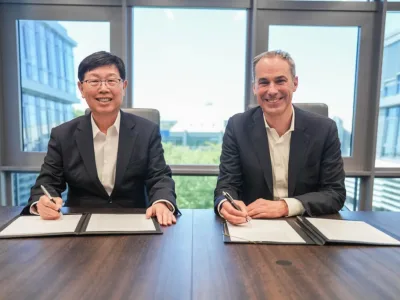
€140m 3D chip research centre opens in Dresden
Fraunhofer IPMS and Fraunhofer IZM-ASSID have opened a flagship €140m research centre for 3D chips in Dresden, Germany.
The Centre for Advanced CMOS & Heterointegration Saxony will provide the complete value chain for 300 mm wafer technology to build 3D chips and heterogeneous systems using substrates and chiplets. It will also work on ways to build neuromorphic and photonic AI and quantum devices on 300mm CMOS wafers.
The two organisation are the only two German research centres for applied microelectronics research based on 300 mm wafer industry standard equipment, working with semiconductor companies and system users as well as material and equipment manufacturers worldwide.
The centre also aims to tap into funding for the European CHIPS Act which aims to boost semiconductor production across the continent. Dresden is the centre of semiconductor production for Europe, although Intel chose another region in Germany, Madegeburg, for its leading edge fab backed by CHIPS Act funds.
Related articles
- EU wants chips with everything
- European Chips Act for semiconductor sovereignty
- ASML visit to boost European CHIPS Act
Fraunhofer IPMS is investing about €140 million in clean room facilities and 300mm front end wafer processing equipment, while Fraunhofer IZM-ASSID is providing packaging and system integration technologies.
The centre will be headed by Dr. Wenke Weinreich, division manager at CNT and deputy institute director of Fraunhofer IPMS, and Dr. Manuela Junghähnel, site manager at IZM-ASSID.
The Centre Nanoelectronic Technologies (CNT) is a business unit of IPMS and has 4000 m² of clean room space of class 6 and 3 (according to ISO 14644-1) as well as laboratory space for more than 80 processing and analytical tools are available. The equipment pool includes deposition and etching equipment as well as inspection and analysis equipment for determining defects and measuring layer properties.
IZM-ASSID has 200-300 mm technology line for 3D wafer-level system integration based on copper-through-silicon-via (Cu-TSV) technology. The process line at Fraunhofer IZM-ASSID is especially designed for production-oriented and industry-compatible development and processing to ISO 9001. Components of the line are process modules for TSV forming, for post-TSV processing, pre-assembly (thinning and separation) and 3D stack forming.
“The joint centre with a clean room of 4000 m² in size enables close cooperation and networking of the scientific and technical competencies of both research institutions. This creates an outstanding R&D technology platform as well as an increase in efficiency and completion of the value chain, which at the same time opens up new research fields,” said Dr. Manuela Junghähnel.
“The 300 mm wafer industry standard is crucial, because it is the only way to ensure a fast transfer of research results to the semiconductor industry in Saxony, nationwide and also worldwide. On the other hand, this wafer standard is also a basic requirement for high-tech research for future technologies, such as neuromorphic and quantum computing,” said Dr. Wenke Weinreich.
“Every third European chip is produced in the Free State of Saxony. With the European Chips Act, the EU has set the course for further investments. The new Fraunhofer Center for semiconductor research is unique in Germany and will make a decisive contribution to innovation in Silicon Saxony. In the future, applied microelectronics research with state-of-the-art 300mm wafers will take place in Dresden at world level,” said Michael Kretschmer, prime minister of Saxony.
The R&D will be designed and expanded in such a way that local and national industry from SMEs to large companies such as Globalfoundries, Infineon and Bosch will be able to benefit from the latest technologies. The integration platform is also used in customer-specific projects as part of the High-Performance Research Fab Microelectronics Germany (FMD).
Other articles on eeNews Europe
- EU standardises on USB-C chargers, wireless
- Apple boosts transistor count in 5nm M2 chip
- Low power DSP for 100 Gbps Coherent Transmission in Optical Access Networks
- Entry level oscilloscope for training and field use
- Sony teams for IoT connectivity for its microcontroller
 If you enjoyed this article, you will like the following ones: don't miss them by subscribing to :
eeNews on Google News
If you enjoyed this article, you will like the following ones: don't miss them by subscribing to :
eeNews on Google News



